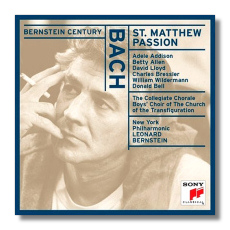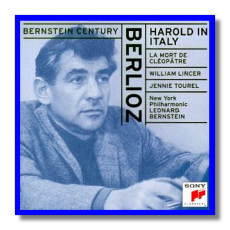
The Internet's Premier Classical Music Source
Related Links
-
J.S. Bach Reviews
Berlioz Reviews - Latest Reviews
- More Reviews
-
By Composer
-
Collections
DVD & Blu-ray
Books
Concert Reviews
Articles/Interviews
Software
Audio
Search Amazon
Recommended Links
Site News
 CD Review
CD Review
Bernstein Century

Johann Sebastian Bach
St. Matthew Passion
- Adele Addison, soprano
- Betty Allen, mezzo-soprano
- David Lloyd (Evangelist), Charles Bressler, tenors
- William Wilderman, bass (Jesus)
- Donald Bell, bass-baritone (Judas, Peter, and Pilate)
The Collegiate Chorale
Boys' Choir of The Church of the Transfiguration
New York Philharmonic Orchestra/Leonard Bernstein
Sony Classical SM2K60727 ADD 2CDs 76:20, 76:56


Hector Berlioz
- Harold in Italy
- La Mort de Cléopâtre
William Lincer, viola
Jennie Tourel, mezzo-soprano
New York Philharmonic Orchestra/Leonard Bernstein
Sony Classical SMK60696 ADD 63:08
Bernstein's 1962 St. Matthew Passion starts off with two strikes against it: it is abridged, and it is sung in English. Nevertheless, one man's grief is another man's joy, and Bach's German vocal music generally adapts itself well to the English language. The adaptation is an old-fashioned one by Troutbeck, and although it frequently departs from the original German and forces singers into prissy constructions of the "despisèd" sort, there's an undeniable immediacy attached to hearing a work such as this one sung in the vernacular. After all, that's how Bach wrote it. It's a little more difficult to apologize for cutting about one-third of the Passion's length. However, it should be noted that this recording was made following live subscription concerts in Carnegie Hall. That Philharmonic audiences should have heard the St. Matthew Passion at all was surprising, and perhaps allowances can be made for Bernstein's daring in programming the work in the first place.
With those caveats out of the way, there is much to admire here. The soloists are an excellent group. The quick vibrato in Lloyd's voice makes him a distinctive Evangelist, and he is an excitable participant in this story of Christ's crucifixion. Wildermann also has an unusual but not unpleasant voice, the sort that immediately attracts one's attention. It would be hard not to be involved with his very human Christ. Addison and Allen sing their solos with dignity and face; Allen's mezzo was a particularly rich and steady instrument at this early stage in her career. The choir alternates dramatic involvement in the turbae with devout purity in the chorales. In 1962, the musicians of the New York Philharmonic included concertmaster John Corigliano, flutist John Wummer, and oboist Harold Gomberg. Each of these gentlemen makes significant contributions to this recording. Finally, Bernstein treats the music tenderly, but he also treats it as a living thing; if this venture has little about it that is scholarly, it has much that is simply honest and communicative. A bonus to this set, as with the original LPs, is the conductor's 16-minute talk on the material and dramatic structure of the St. Matthew Passion. Although this is not everyone's recording of this work, it should not be "despisèd" before being given a chance. It may be just the thing for people who have delayed exploring this work because they find it too daunting.
The best reason for acquiring the Berlioz disc is Lincer's glorious reading of the solo viola part in Harold in Italy. This is viola-playing at its most melting, and it instills deep sympathy in the listener for the fate of Berlioz's (and Lord Byron's) luckless hero. In fact, this Harold is too nice a guy for these things to happen to; no wonder he is practically shocked into total silence (and death) in the hectic fourth movement, which is an "Orgy of the Brigands." Bernstein's conducting is alternately offhanded and obvious, as if he didn't believe in Berlioz's admittedly elusive score, or didn't quite know what to make of it. The interior movements are better than the outer ones; I like the accented horns at the phrase-ends near the start of "March of the Pilgrims," a movement that might be described as "breezy" in Bernstein's conception.
Berlioz wrote La Mort de Cléopâtre in his third unsuccessful bid for the Prix de Rome. (The fourth time was a charm, but the winning work, La Mort de Sardanapale, no longer exists in toto.) This "scène lyrique" from 1830 is something of a warm-up for Dido's music in Les Troyens. At times it soars (a melody that later appeared in Le Carnaval Romain appears midway through), and at other times it stumbles. One highly characteristic touch is the orchestral yelp that depicts Cleopatra's wounding by the asp. The panting strings that follow this are a convincing picture of a faltering heartbeat.
Bernstein's soloist is his friend and frequent colleague Jennie Tourel, a masterful singer, and one whose sympathy for the French language helps to sell this work. Not to be ungallant, but she sounds too long in the tooth to be totally convincing as the Egyptian beauty, and two of her high notes are yelps of quite a different sort. Bernstein is the helpful accompanist here; it's not clear to me what attracted him to this score in the first place because it doesn't give him and the orchestra much to do. Janet Baker remains first choice in this work, but Bernstein fans will not be seriously displeased by either this version or by Harold. Both recordings date from 1961.
Copyright © 1999, Raymond Tuttle




















